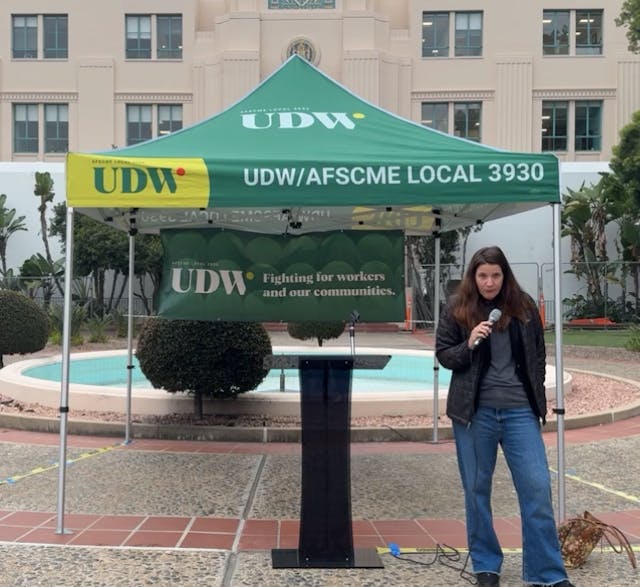The Sound and Soul of Acapulco
Frontera NorteSur
As dusk stirs, Acapulco’s Zocalo, or town square, becomes a cacophony of sounds. On a given day, visitors might hear a woman street musician playing a violin, the municipal orchestra soothing a mainly older audience, a poet reading revolutionary verse, or a clown tickling the old funny bones.
On one side of the old plaza, the pirate CD vendor cranks up a sample of popular banda music, while cavernous-like murmurs drift out from the Cathedral with its Virgin of Soledad, the protector of Acapulco. And like clockwork, noisy grackle birds lay down the back track in a tree-stand chorus.
Despite their historic importance, Acapulco’s Zocalo and adjacent barrios witnessed hard times in recent years. As crime and violence intensified and tourism plunged, businesses shut down or downsized.
Rosario Padua, owner of the Astoria Café, an iconic but struggling hangout for intellectuals and die-hard regulars who savor the local, Guerrero-produced coffee, was noticeably pleased, then, when a trio of workers from the Guerrero state government began taking measurements of the Zocalo for an upcoming renovation.
“It’s magnificent that they are here,” Padua said while taking a break from her outdoor kitchen. “It’s the prettiest zone of Acapulco. Remember the artists who came here.”
Padua is definitely a partisan of an old-school look and feel for a new Zocalo. She proposed more theatrical events and sessions of danzon, the sexy but classy dances still popular among older people, for the bayside plaza. “Maybe put in a marimba and artistic events, not pirate CDs,” Padua implored.
Dr. Dulce Maria Gomez Velasco Sadala, longtime Acapulco resident and dentist, is likewise squarely in favor of a Zocalo facelift. Gomez serves as the president of the Front for the Rescue of Traditional Acapulco (FRAT), a civil society group that has long clamored for the revival of the older districts of Aca-pulco, the places that made the Mexican resort a famous international destination many decades ago.
“As a group, we’ve asked for the federal and state governments to dignify the Zocalo,” Gomez said during an interview held at one of the patio tables of Padua’s shady café. According to Gomez, some quarters of government are moving on FRAT’S long-standing concerns, especially the federal administration of President Enrique Pena Nieto and the state administration of Governor Angel Aguirre.
“We’ve asked administration after administration but haven’t gotten any echo, considering all the problems the state of Guerrero has. Only Enrique Pena Nieto and Agui-rre have focused on rescuing Acapulco,” she said.
Although a master plan and budget for the Zocalo’s reconstruction has still to be unveiled, Gomez ventured that the streets need new drains, the walls unifying and the Cathedral illuminating.
Other local projects are in the works, she added, including the construction of small bridges to connect beaches, the building of platforms so onlookers can have an easier time watching divers make their daredevil leaps from the cliffs of La Quebrada, and the declaration of a downtown historic zone.
Gomez is a proud Acapulquena. Her family roots trace to Lebanese grandparents, who came to the Pacific port nearly 100 years ago amid the chaos of the geo-political carve-up of the post-World War One Middle East, to reinvent their lives as grain merchants and help “detonate” the local economy.
In the 21st century, another descendant of Lebanese immigrants, Carlos Slim, has a hand in developing Acapulco, Gomez noted. The Mexican magnate has purchased and renovated the lengendary Boca Chica Hotel on Caletilla Beach, an old haunt of the Hollywood celebrities known as the “Rat Pack” back in the 1950s and 1960s, and has expressed interest in other projects in partnership with the state and federal governments.
“What they want to do is fix up the house, so visitors will be offered a new, traditional Acapulco with better facilities,” Gomez said. “We see that as a good Lebanese, Carlos Slim will detonate traditional Aca-pulco, because nobody else has.”
In the last decade, Slim’s ocean deep pockets were critical in the revitalization of Mexico City’s Zocalo during the administration of former Mayor Andres Manuel Lopez Obrador. Since then, other Mexican cities have embarked on downtown projects, with Aguascalientes and Ciudad Juarez among the latest.
Others have their own visions of a new day for traditional Acapulco. Every last Sunday of the month, people gather for a book exchange and readings on the Zocalo. Meant to promote reading and displayed for the public’s picking, the eclectic titles encompass scientific, religious and radical themes. Anyone with the literary gumption can stroll up to the microphone and read his or her favorite passage. Occasionally, street theater and “popular assemblies” are held.
In the run-up to this year’s International Women’s Day on March 8, community members gathered to discuss plans for a commemoration. “This is becoming a cultural event, and people even come to sell their homemade crafts,” said Dario Velasco, a 21-year-old member of Acapulco’s branch of #Yo Soy 132 and an organizer of Zocalo Sundays.
Originally, #Yo Soy 132 emerged as a youth protest movement against media bias for the presidential candidacy of Enrique Pena Nieto during the 2012 elections.
While many of the group’s branches have since faded from the political scene, the Acapulco organization remains active on a host of issues-opposing genetically modified food, fighting to protect the environment and assisting residents of rural Guerrero who were somehow left out of the government aid loop after last year’s Tropical Storm Manuel devastated regions of the state, among others.
Like previous generations of Acapulquenos, VelaAAsco and fellow 132er Hugo Ozuna view the Zocalo and its surrounding neighborhoods, or historic barrios, as the core of the city. Providing a public space for community members to interact and exchange ideas is crucial for democracy and community viability, Velasco affirmed.
“We see this as basic for changing into a society that is more informed and participatory,” he said.
Like elsewhere in Mexico, the importance of the Zocalo to the local cultural fabric cannot be underestimated. The plazas are places where the sacred and the secular, the commercial and the non-commercial and the trendy and well-worn meet, mesh and clash. If something is happening, whether it is a religious procession, political rally, hunger strike, musical performance, or traditional dance, the Zocalo is a likely place. Regularly, friends socialize, couples snuggle and residents catch up on the news in the Zocalo.
As the project to give the Acapulco Zocalo a make-over takes shape, public debate over the design, spending priorities and definitions of the culture to be promoted will surely resound. Overall, the city needs more attention on popular culture, Velasco and Ozuna argued.
The young activists reiterated a criticism made by hundreds of local cultural personalities earlier this year of the proposed channeling, via the office of federal legislator Man-uel Anorve, of about $2 million in public money to a private group for the construction of a church cultural center. The allocation was earmarked at the same time the local public library is starved for funds, Velasco said.
“It’s unjust,” Ozuna added. “Culture should be secular.”
The FRAT’s Dulce Gomez insisted that traditional Aca-pulco, which she defined as the part of the city that extends from the La Quebrada cliffs to the statue of Diana the Huntress on the Costera tourist main drag, is special and distinct from the long sprawl that winds out to the sands of the Mayan Palace Hotel, flagged along the way by Walmart, fast food chains, casinos, and towering hotels.
“This is Acapulco,” Go-mez beamed. “We’re different. We’re from the people.”
Frontera NorteSur: on-line, U.S.-Mexico border news Center for Latin American and Border Studies New Mexico State University Las Cruces, New Mexico.






